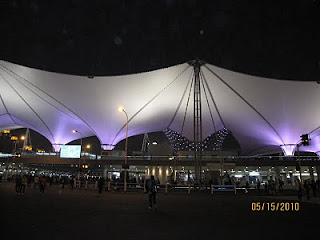
 above: the central axis of the expo, which houses restaurants and shops. It features six rain water collection towers, in line with the environmentalist theme of the expo.
above: the central axis of the expo, which houses restaurants and shops. It features six rain water collection towers, in line with the environmentalist theme of the expo.below: Macao, a giant rabbit. It has nothing to do with Macao but was inspired by a Chinese folk tale about the rabbit in the moon. I-Ping and I are both born in the year of the rabbit.

The main exhibits are in Pudong (east of the river); the science and technology area is in Puxi, on the other side. Below, the ship building pavilion, housed in a former shipyard. Featured a model floating farm, a huge ship that would desalinate water and grow, on different decks, fruit, vegetables, and grain. Designed but not yet built. An interesting solution for dealing with lack of agricultural land (which is itself a man made problem) but the carbon foot print for transporting back to consumers would be considerable.
 The earth pavilion. (translation of sign below: We only have one earth) Sorry no photos from inside but this had some of the best exhibits of entire expo--one on "city being" (bad translation, they really mean city life) which had remarkable videos of urban life in Buenos Aires, Naibobi, Chengdu (post-earthquake, very moving), Edmonton... and one called "urban planet" on climate change, which culminated with a huge 'blue planet' covered with video simulations of the oceans rising, land masses giving way, and the earth recycling. (for more, see link, left)
The earth pavilion. (translation of sign below: We only have one earth) Sorry no photos from inside but this had some of the best exhibits of entire expo--one on "city being" (bad translation, they really mean city life) which had remarkable videos of urban life in Buenos Aires, Naibobi, Chengdu (post-earthquake, very moving), Edmonton... and one called "urban planet" on climate change, which culminated with a huge 'blue planet' covered with video simulations of the oceans rising, land masses giving way, and the earth recycling. (for more, see link, left)There was also a "best urban practices" pavilion in Puxi, with case studies from around the world. Best one in my opinion was Sao Paolo, which has banned all outdoor advertising (billboards, walls, etc--"visual pollution") and limits the size of store signage.
 China pavilion at night. See the people on the escalator and on the second level for sense of scale.
China pavilion at night. See the people on the escalator and on the second level for sense of scale.
Inside the Iranian pavilion. Predictable exhibits (industry, technology; but did you know there are ski resorts in Iran?) but upstairs they were selling persian rugs--at very good prices too, I might add. They said they would ship to anywhere, but...

United Kingdom: Seed Cathedral, constructed with 600,000 (or 60,000? not sure) acrylic rods; at the end of each one (seen from inside) is a seed. Kew Botanical Garden's "Millennium seed project," to collect (every existing??) seed as a way to memorialize the biodiversity of the world.


 Taiwan pavilion, with huge video globe inside. Designed by Li Zhuyuan (Taipei 101).
Taiwan pavilion, with huge video globe inside. Designed by Li Zhuyuan (Taipei 101).
Japan pavilion is dubbed the purple silkworm island. Three+ hour wait so we did not go in. Apparently, interesting robotics inside. Its restaurant is expo's most expensive and is booked through July.

The USA pavilion was, by the way, terrible. US had first decided not to participate, citing budgetary restraints, then joined at the 11th hour. To not have come would have looked very bad. The exhibit comprised three hastily made videos, all fluff (children with dreams), no substantive content. Because of late entry, the pavilion is the very last one. Not coincidentally, perhaps, it is also at greatest distance from N Korea and Iran pavilions.
I will say that the amenities were pretty good. Lots of water fountains and restrooms (very clean and no shortage of TP) and areas to sit. Food situation not so great: Pavilion restaurants with national cuisines tended to be very expensive. Food for the masses was plentiful but there were often lines. We ate sandwiches at Starbucks one day; had Taiwan beef noodle soup when we went at night; and stood on line in front of the Belgium pavilion for Belgian waffles that were tasty but the size of a silver dollar. And no whipped cream.
No comments:
Post a Comment